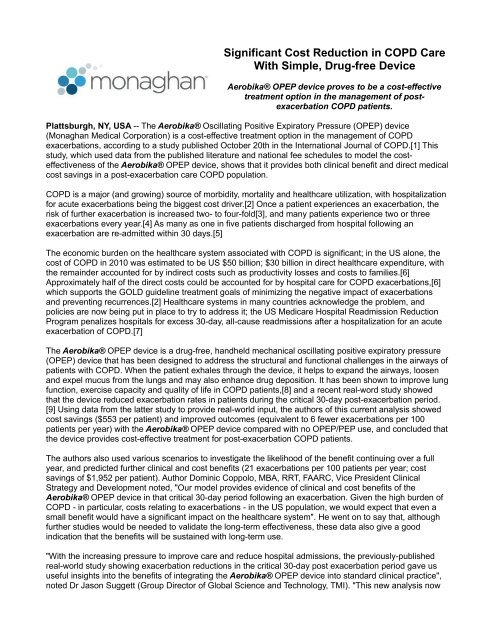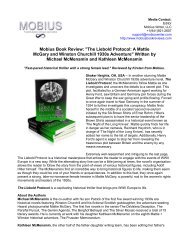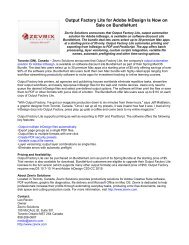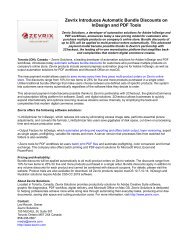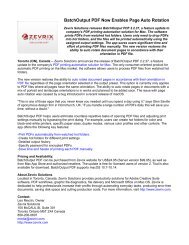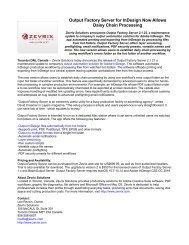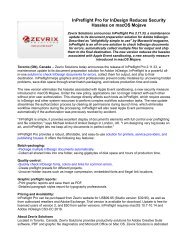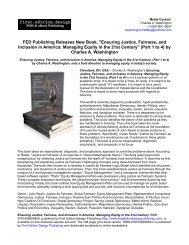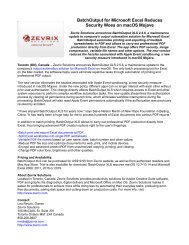Significant Cost Reduction in COPD Care With Simple, Drug-free Device
Aerobika® OPEP device proves to be a cost-effective treatment option in the management of post-exacerbation COPD patients.
Aerobika® OPEP device proves to be a cost-effective treatment option in the management of post-exacerbation COPD patients.
- TAGS
- staronepr
You also want an ePaper? Increase the reach of your titles
YUMPU automatically turns print PDFs into web optimized ePapers that Google loves.
<strong>Significant</strong> <strong>Cost</strong> <strong>Reduction</strong> <strong>in</strong> <strong>COPD</strong> <strong>Care</strong><br />
<strong>With</strong> <strong>Simple</strong>, <strong>Drug</strong>-<strong>free</strong> <strong>Device</strong><br />
Aerobika® OPEP device proves to be a cost-effective<br />
treatment option <strong>in</strong> the management of postexacerbation<br />
<strong>COPD</strong> patients.<br />
Plattsburgh, NY, USA -- The Aerobika® Oscillat<strong>in</strong>g Positive Expiratory Pressure (OPEP) device<br />
(Monaghan Medical Corporation) is a cost-effective treatment option <strong>in</strong> the management of <strong>COPD</strong><br />
exacerbations, accord<strong>in</strong>g to a study published October 20th <strong>in</strong> the International Journal of <strong>COPD</strong>.[1] This<br />
study, which used data from the published literature and national fee schedules to model the costeffectiveness<br />
of the Aerobika® OPEP device, shows that it provides both cl<strong>in</strong>ical benefit and direct medical<br />
cost sav<strong>in</strong>gs <strong>in</strong> a post-exacerbation care <strong>COPD</strong> population.<br />
<strong>COPD</strong> is a major (and grow<strong>in</strong>g) source of morbidity, mortality and healthcare utilization, with hospitalization<br />
for acute exacerbations be<strong>in</strong>g the biggest cost driver.[2] Once a patient experiences an exacerbation, the<br />
risk of further exacerbation is <strong>in</strong>creased two- to four-fold[3], and many patients experience two or three<br />
exacerbations every year.[4] As many as one <strong>in</strong> five patients discharged from hospital follow<strong>in</strong>g an<br />
exacerbation are re-admitted with<strong>in</strong> 30 days.[5]<br />
The economic burden on the healthcare system associated with <strong>COPD</strong> is significant; <strong>in</strong> the US alone, the<br />
cost of <strong>COPD</strong> <strong>in</strong> 2010 was estimated to be US $50 billion; $30 billion <strong>in</strong> direct healthcare expenditure, with<br />
the rema<strong>in</strong>der accounted for by <strong>in</strong>direct costs such as productivity losses and costs to families.[6]<br />
Approximately half of the direct costs could be accounted for by hospital care for <strong>COPD</strong> exacerbations,[6]<br />
which supports the GOLD guidel<strong>in</strong>e treatment goals of m<strong>in</strong>imiz<strong>in</strong>g the negative impact of exacerbations<br />
and prevent<strong>in</strong>g recurrences.[2] Healthcare systems <strong>in</strong> many countries acknowledge the problem, and<br />
policies are now be<strong>in</strong>g put <strong>in</strong> place to try to address it; the US Medicare Hospital Readmission <strong>Reduction</strong><br />
Program penalizes hospitals for excess 30-day, all-cause readmissions after a hospitalization for an acute<br />
exacerbation of <strong>COPD</strong>.[7]<br />
The Aerobika® OPEP device is a drug-<strong>free</strong>, handheld mechanical oscillat<strong>in</strong>g positive expiratory pressure<br />
(OPEP) device that has been designed to address the structural and functional challenges <strong>in</strong> the airways of<br />
patients with <strong>COPD</strong>. When the patient exhales through the device, it helps to expand the airways, loosen<br />
and expel mucus from the lungs and may also enhance drug deposition. It has been shown to improve lung<br />
function, exercise capacity and quality of life <strong>in</strong> <strong>COPD</strong> patients,[8] and a recent real-word study showed<br />
that the device reduced exacerbation rates <strong>in</strong> patients dur<strong>in</strong>g the critical 30-day post-exacerbation period.<br />
[9] Us<strong>in</strong>g data from the latter study to provide real-world <strong>in</strong>put, the authors of this current analysis showed<br />
cost sav<strong>in</strong>gs ($553 per patient) and improved outcomes (equivalent to 6 fewer exacerbations per 100<br />
patients per year) with the Aerobika® OPEP device compared with no OPEP/PEP use, and concluded that<br />
the device provides cost-effective treatment for post-exacerbation <strong>COPD</strong> patients.<br />
The authors also used various scenarios to <strong>in</strong>vestigate the likelihood of the benefit cont<strong>in</strong>u<strong>in</strong>g over a full<br />
year, and predicted further cl<strong>in</strong>ical and cost benefits (21 exacerbations per 100 patients per year; cost<br />
sav<strong>in</strong>gs of $1,952 per patient). Author Dom<strong>in</strong>ic Coppolo, MBA, RRT, FAARC, Vice President Cl<strong>in</strong>ical<br />
Strategy and Development noted, "Our model provides evidence of cl<strong>in</strong>ical and cost benefits of the<br />
Aerobika® OPEP device <strong>in</strong> that critical 30-day period follow<strong>in</strong>g an exacerbation. Given the high burden of<br />
<strong>COPD</strong> - <strong>in</strong> particular, costs relat<strong>in</strong>g to exacerbations - <strong>in</strong> the US population, we would expect that even a<br />
small benefit would have a significant impact on the healthcare system". He went on to say that, although<br />
further studies would be needed to validate the long-term effectiveness, these data also give a good<br />
<strong>in</strong>dication that the benefits will be susta<strong>in</strong>ed with long-term use.<br />
"<strong>With</strong> the <strong>in</strong>creas<strong>in</strong>g pressure to improve care and reduce hospital admissions, the previously-published<br />
real-world study show<strong>in</strong>g exacerbation reductions <strong>in</strong> the critical 30-day post exacerbation period gave us<br />
useful <strong>in</strong>sights <strong>in</strong>to the benefits of <strong>in</strong>tegrat<strong>in</strong>g the Aerobika® OPEP device <strong>in</strong>to standard cl<strong>in</strong>ical practice",<br />
noted Dr Jason Suggett (Group Director of Global Science and Technology, TMI). "This new analysis now
gives us clear evidence that such cl<strong>in</strong>ical benefits would be translated <strong>in</strong>to cost-effectiveness <strong>in</strong> this postexacerbation<br />
population. In addition, new data presented at CHEST 2017 demonstrat<strong>in</strong>g that the<br />
generation of the proprietary pressure/oscillation pattern of the Aerobika* device efficiently generates<br />
oscillations throughout a high percentage of each exhaled breath, and with consistently high pressure<br />
amplitudes. The Aerobika* device demonstrated efficient and effective performance related to therapeutic<br />
effectiveness nearly twice that of other devices tested."[10]<br />
About Monaghan Medical Corporation (MMC, USA)<br />
MMC offers lead<strong>in</strong>g aerosol drug delivery devices and respiratory management products <strong>in</strong>clud<strong>in</strong>g<br />
AeroEclipse® II BAN, AeroChamber Plus® aVHC and the Aerobika® device<br />
(http://www.monaghanmed.com/aerobika) exclusively <strong>in</strong> the United States. MMC's strength lies <strong>in</strong> product<br />
development around core capabilities <strong>in</strong> mechanical design complimented by collaboration with a state-ofthe-art<br />
aerosol research laboratory. MMC focuses on develop<strong>in</strong>g cost-efficient, outcome-based solutions for<br />
its customers.<br />
About the Aerobika® device<br />
The Aerobika® OPEP device (http://www.monaghanmed.com/Aerobika-OPEP) is a hand-held, robust,<br />
easy-to-use, drug-<strong>free</strong> oscillat<strong>in</strong>g positive expiratory pressure (OPEP) device designed to help expel mucus<br />
from the lungs, expand airways and enhance drug deposition. When the patient exhales through the<br />
device, <strong>in</strong>termittent resistance creates a unique pressure-oscillation dynamic, which expands the airways,<br />
helps expel the mucus to the upper airways where it can be coughed out. The Aerobika® OPEP device is<br />
designed to function <strong>in</strong>dependent of angle of use or flow rate, and allows for a direct aerosol pathway for<br />
patients us<strong>in</strong>g a nebulizer for medication delivery. The Aerobika® OPEP device has been shown to<br />
significantly improve forced vital capacity (FVC), 6-m<strong>in</strong> walk distance (6MWD), and St. George's<br />
Respiratory Questionnaire (SGRQ) score <strong>in</strong> <strong>COPD</strong> patients.[8] The Aerobika® OPEP device is available <strong>in</strong><br />
the US via Monaghan Medical Corporation (http://www.monaghanmed.com), and <strong>in</strong> Canada, Mexico, and<br />
select European countries <strong>in</strong>clud<strong>in</strong>g the UK and Germany through Trudell Medical International<br />
(http://www.trudellmed.com).<br />
About the study<br />
A one-year Markov model was used to estimate the cost-effectiveness of the Aerobika® OPEP device <strong>in</strong><br />
patients who had experienced an exacerbation <strong>in</strong> the previous month, or a post-exacerbation care<br />
population, with <strong>in</strong>put data from the published literature and national fee schedules. Us<strong>in</strong>g a base-case<br />
assumption that the benefit of the Aerobika® OPEP device would last 30 days, cost-sav<strong>in</strong>gs ($553 per<br />
patient) and improved outcomes (ie, 6 fewer exacerbations per 100 patients per year) were demonstrated<br />
when compared with no OPEP/positive expiratory pressure use. Assum<strong>in</strong>g a scenario with effect beyond<br />
the conservative 30 day time frame, the Aerobika® OPEP device cont<strong>in</strong>ued to show benefit (21<br />
exacerbations per 100 patients per year; cost sav<strong>in</strong>gs of $1,952 per patient). One-way sensitivity analyses<br />
were conducted for all <strong>in</strong>put variables, <strong>in</strong>creas<strong>in</strong>g or decreas<strong>in</strong>g the effect by 20%, to determ<strong>in</strong>e the impact<br />
of change on costs and health effects; the results supported the robustness of the base-case conclusions.<br />
For cl<strong>in</strong>ical <strong>in</strong>quiries, please contact:<br />
Dom<strong>in</strong>ic P. Coppolo, MBA, RRT, FAARC<br />
Vice President Cl<strong>in</strong>ical Strategy and Development<br />
Monaghan Medical Corporation<br />
1-800-343-9071<br />
Words or phrases accompanied by ® are trademarks and registered trademarks of Monaghan Medical Corporation or an affiliate of<br />
Monaghan Medical Corporation. © 2017 Monaghan Medical Corporation.<br />
1. Khoudigian S, Kowal S, Suggett J, D. C. <strong>Cost</strong>-effectiveness of the Aerobika* oscillat<strong>in</strong>g positive<br />
expiratory pressure device <strong>in</strong> the management of <strong>COPD</strong> exacerbations. International journal of chronic<br />
obstructive pulmonary disease. 2017;In Press.<br />
2. Global strategy for the diagnosis, management and prevention of <strong>COPD</strong>, Global Initiative for Chronic<br />
Obstructive Lung Disease (GOLD) 2017.<br />
3. Khakban A, S<strong>in</strong> DD, FitzGerald JM, et al. The Projected Epidemic of Chronic Obstructive Pulmonary
Disease Hospitalizations over the Next 15 Years. A Population-based Perspective. Am J Respir Crit <strong>Care</strong><br />
Med. 2017;195(3):287-291.<br />
4. Puhan MA, Chandra D, Mosenifar Z, et al. The m<strong>in</strong>imal important difference of exercise tests <strong>in</strong> severe<br />
<strong>COPD</strong>. Eur Respir J. 2011;37(4):784-790.<br />
5. Guerrero M, Crisafulli E, Liapikou A, et al. Readmission for Acute Exacerbation with<strong>in</strong> 30 Days of<br />
Discharge Is Associated with a Subsequent Progressive Increase <strong>in</strong> Mortality Risk <strong>in</strong> <strong>COPD</strong> Patients: A<br />
Long-Term Observational Study. PLoS One. 2016;11(3):e0150737.<br />
6. Guarascio AJ, Ray SM, F<strong>in</strong>ch CK, Self TH. The cl<strong>in</strong>ical and economic burden of chronic obstructive<br />
pulmonary disease <strong>in</strong> the USA. Cl<strong>in</strong>icoecon Outcomes Res. 2013;5:235-245.<br />
7. Shah T, Press VG, Huis<strong>in</strong>gh-Scheetz M, White SR. <strong>COPD</strong> Readmissions: Address<strong>in</strong>g <strong>COPD</strong> <strong>in</strong> the Era<br />
of Value-based Health <strong>Care</strong>. Chest. 2016;150(4):916-926.<br />
8. Svenn<strong>in</strong>gsen S, Paul<strong>in</strong> GA, Sheikh K, et al. Oscillatory Positive Expiratory Pressure <strong>in</strong> Chronic<br />
Obstructive Pulmonary Disease. <strong>COPD</strong>. 2016;13(1):66-74.<br />
9. Burudpakdee C, Seetasith A, Dunne P, et al. A real-world study of 30-day exacerbation outcomes <strong>in</strong><br />
chronic obstructive pulmonary disease (<strong>COPD</strong>) patient managed with Aerobika OPEP. Pulmonary<br />
Therapeutics. 2017.<br />
10. Meyer A and Suggett J. A Laboratory Assessment <strong>in</strong>to the Efficiency and Effectiveness of Different<br />
Oscillat<strong>in</strong>g Positive Expiratory Pressure <strong>Device</strong>s by Means of Patient Simulated Expiratory Waveforms.<br />
Presented at CHEST 2017.


